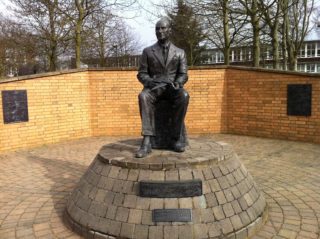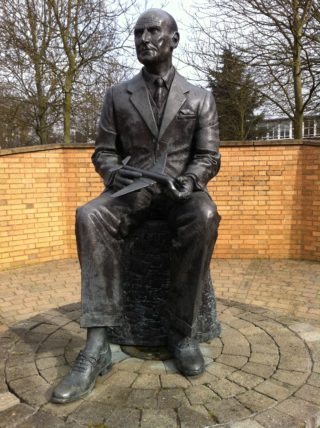Sir Geoffrey de Havilland
By Abi Wilson
Early Life
Sir Geoffrey de Havilland was born on 27 July 1882 in High Wycombe, Buckinghamshire. It was expected that at the age of 17 Geoffrey would train for the clergy. However, his interest in mechanics overshadowed previous expectations and Geoffrey went on to train at the Crystal Palace Engineering School in 1900. The school provided Geoffrey with knowledge of mechanical engineering and with this he built his own motorcycle.
Early Work
After three years he gained an apprenticeship at Willans & Robinson in Warwickshire and in 1905 he became a draughtsman at the Wolsleley Tool & Motor Car Company at Adderley Park in Birmingham. After working for the Daimler Motor Company, Geoffrey’s brother (Ivon) designed the Iris car which was manufactured at Willesden, London. Ivon introduced Geoffrey to a number of people who would help him in his future.
Inspired by Wilbur Wright in 1908 Geoffrey knew that his future would revolve around aviation. With financial aid from his maternal Grandfather Geoffrey started to design his first aeroplane. Although his first aeroplane was unsuccessful his second took flight in 1910. The plane was bought by the British Army’s balloon factory at Farnborough and de Havilland was given a job as a pilot and aircraft designer.
The de Havilland Aircraft Company
At the end of the First World War Geoffrey set up the de Havilland Aircraft Company with the help of former colleagues. The most successful product to come out of this company was the Moth series of biplanes.
In 1934 the de Havilland Comet Racer won a race from London to Melbourne in under seventy-one hours. In the following year the company pioneered the British manufacture of American controllable pitch propellers, which would become crucial in winning the battle of Britain.
At the outbreak of World War Two the company was manufacturing the Tiger Moth and Dragon Rapide biplanes and most importantly, the Mosquito. The Tiger Moth, which was first sold in 1931, was predominantly used for the Royal Air Force to train in during the Second World War
Tragedy
In 1946 Geoffrey de Havilland Junior was partaking in a test flight when the aircraft broke up near Gravesend in Kent. The death of Geoffrey Jnr not only affected his family but also the entirety of the company. Geoffrey’s youngest son, John, also died in an air collision. It was shortly after this that Geoffrey’s wife also passed away.
Retirement
In 1960 the de Havilland group was acquired by Hawker Siddeley and Geoffrey’s role within the company diminished. Geoffrey carried on flying planes long after his retirement but sadly died in 1965 of a cerebral haemorrhage.
Honours
Geoffrey was awarded an OBE in 1918, a CBE in 194 and he received the Air Force Cross in 1919. As well as this Geoffrey was knighted in 1944 and appointed to the Order of Merit in 1962.
Autobiography
The autobiography of Geoffrey de Havilland was published in 1961 and is available to buy. The name of his book is Sky Fever.








Add your comment about this page